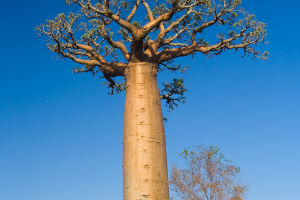With the development of the transportation industry, even in a country that is cold all year round, you can eat seasonal fruits that grow in tropical areas.
As one of the more common fruits in our lives, bananas are naturally loved by many people.
But because bananas are a kind of fruit that is relatively easy to damage, even if seasonal bananas are available in a place that is cold all year round, their taste is naturally very different from that of real fully ripe bananas. Therefore, many tourists often taste these fruits when they travel to tropical areas.
The banana tree we are going to talk about today is very special. It is known as the largest banana tree in the world. The banana fruit produced by this tree needs several people to eat it together.
It is the largest banana tree in the world, with a height of 25 meters!
In many people's minds, bananas are a very common fruit. Eating a banana basically does not feel full, and some people even feel hungrier after eating a banana.
But the banana we are going to talk about today can make several people full. The name of this banana tree is Musia Ingens, which is a non-woody plant that grows in Papua New Guinea.
This kind of tree can grow up to 25 meters, which is about 5 times that of ordinary banana trees, and it takes four or five adults to hug thetrunk. When people walked into the woods of Musia Ingens, there were large leaves everywhere.
The fruits of Musia Ingens are more than ten times larger than ordinary bananas. On average, it can grow to the thickness of a female arm, and the length is about 30 cm. People need to use two palms to hold it.
The average weight of the fruit is about 3-4 kg, and the largest can reach about 6kg. This is also the largest known banana in the world. Many people may think that the taste of bananas will become worse when they grow so big.
But in fact, although the banana grows so big, its taste is almost the same as the banana we eat. When the locals welcome tourists, they will also warmly take out these bananas as a treat.
When tourists taste these bananas, they often show surprised expressions. And this giant banana tree, in addition to producing huge and delicious bananas, also has many unexpected functions.
For example, banana leaves, the leaves of this tree are rich in fiber. After special processing, the leaves can be used to make paper, and even local people use them to build houses.
Another example is the trunk of a banana tree. In the impression of many people, the trunk of a banana tree is often like a sponge. But the trunk of this Musia Ingens can be brewed into a delicious drink, and it is also brought out by locals to entertain tourists.
The last is the banana peels left over from the bananas. These peels contain more nutrients. The local people will mash them to make feed to feed livestock. Animals also love to eat them.
In addition to these three uses that locals often take advantage of, if someone gets lost in the woods when it's raining. The leaves can also be folded off to act as a temporary canopy. Or during outings, the big leaves can also be used as picnic mats.
However, visitors to the area should also be reminded that some parts of the Musia Ingens tree contain a small number of toxins. If you don't know the conditions of these trees, then don't taste them with curiosity to avoid poisoning.


